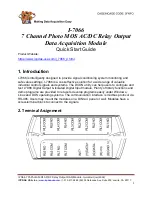
SMAC
LAC-26 Technical Reference Manual
4/29/2013 74
6.
Configure Drive Limits and Events: DriveWare allows the user to manually configure system
parameters and limits, and assign "actions" to specific events. The limits and their corresponding actions are
used as both safety measures to avoid system damage, as well as parameter observation tools for drive
configuration and troubleshooting.
7.
Tune the Current Loop: Once the drive parameters are configured properly, the current loop must
be tuned. This is the innermost loop and forms the basis of all motion. The current loop gains can be
calculated based on the motor and application data entered in the previous two steps, or they can be set
manually. The DriveWare Software Manual contains instructions on current loop tuning.
8.
Commutate the Motor: For Three Phase (Brushless) motors, commutation is necessary to maintain
the optimal torque generation at any motor position. Typically this is accomplished by running the
AutoCommutation routing in DriveWare. Also see “Commutation” on page 44.
Once the drive has been commutated successfully, the drive is ready for further use, such as velocity or
position loop tuning. Consult the DriveWare Software Manual for the correct procedure.
6.1.2 Commutation
Motor commutation is the process that maintains an optimal angle between the magnetic field created by
the permanent magnets in the motor and the electromagnetic field created by the currents running through
the motor windings. This process ensures optimal torque or force generation at any motor position. Single
phase (brushed) motors accomplish this process with internal commutators built into the motor housing.
Three phase (brushless) motors require a correctly configured drive to commutate properly, however. There
are two ways to configure a DZ digital drive to commutate a three phase (brushless) motor in DriveWare:
•
AutoCommutation: Most applications can use the AutoCommutation routine in DriveWare for
configuring a drive to a specific motor. This routine will automatically detect the feedback devices attached
to the motor and ask the user to verify them against the motor’s data sheet.
•
Manual Commutation: This process requires more time, and may not be as accurate as
AutoCommutation. This method will have to be performed if:
— The motor is mechanically restrained such that it is unable to rotate (AutoCommutation requires the
motor to rotate 2 revol 1 electrical cycle in both directions for a rotary motor, and 3 electrical cycles
for a linear motor).
— The motor or load has a significant amount of inertia.
For three phase (brushless) drives that use encoder feedback but no Hall Sensors, it is required to run the
"Phase Detect" routine in DriveWare before AutoCommutation. Phase Detect works by sending a small
current signal to the motor, prompting the motor to vibrate slightly for a few seconds. The encoder feedback
from this movement provides a starting position for the motor, allowing the drive to then be properly
commutated.
See the DriveWare Software Manual for more information on AutoCommutation, Manual Commutation, and
Phase Detect.












































